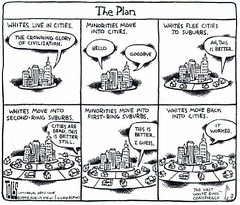Saturday musings on "gentrification," change and what, if anything, can we do
 Tom Toles is now the editorial cartoonist for the Washington Post. He had been at the Buffalo News for a long long time and I've always loved his work. This cartoon is from 1998, long before he came to Washington.
Tom Toles is now the editorial cartoonist for the Washington Post. He had been at the Buffalo News for a long long time and I've always loved his work. This cartoon is from 1998, long before he came to Washington.Something I wrote today, on the columbia_heights yahoogroup, in response to the ongoing e-conversation about the pernicious effects of gentrification vs. the positives that come from new residents and new investment, and the question of "who deserves it more" in terms of having the right or privilege of being able to participate in the conversation of "what do we do now?"
You can't put the genie back in the bottle. You need a mix of incomes, including higher incomes, in order to have a functioning, thriving community. At the same time, I think it's reasonable and honorable to fulminate about how change is occuring in the District.
But these trends are trends, just like people coming back to the city is a real trend.
People began leaving the city beginning in the 1930s as they sought the suburbanized "American Dream," DC, like most other center cities, suffered. White flight after school integration, which led to retail and other business leakage, plus the destruction of neighborhood business districts after the assasination of Dr. King, further destabilized neighborhoods and the economy of the center city.
I mentioned in my blog that recently I found a planning report from Fairfax County published in 1962(!!!!) about sprawl and "The Vanishing Land", that subdivision development was eliminating open space and occuring willy-nilly.
These disinvestment trends that harmed the center city have been long standing
For years, I have been uncomfortable with the term "gentrification," because I think that it's used too often to obscure rather than to explain, and it tars all that is good about reinvestment in the center city. Disinvestment is never a good thing.
Why I now am willing to use the word comes from linking the changes that come from the influx of new people and new money with the impact on the existing residents of an area. If there are few plans and programs that assist in minimizing-mitigating the negatives of displacement forced by market changes, then I define that as gentrification in the sorry sense of the word.
Whose role is it to play in minimizing the negative effects? Well, I think that comes mostly from government. Why Lance Freeman in NYC (he's at Columbia) has found "minimal" displacement of lower income residents from gentrifying neighborhoods in NYC is explained by the fact that NYC has more housing support programs for lower- and middle-income people of any jurisdiction in the United States.
I agree with William that we are not doing a very good job on such issues in DC.
But then I am incredibly depressed these days about "how bad" we go about planning and change in the city, in terms of (1) baseball; (2) National Capital Medical Center; (3) DC Public Schools; (4) the Comprehensive Plan revision process; (5) the Library planning process; (6) planning for cultural resources development and management including historic preservation, arts and cultural institutional planning and development, and local cultural heritage and tourism opportunities; and (7) the development of an agenda and support programs for the development of independent businesses (as well as an element for "Building a Local Economy" as part of the Comprehensive Plan).
We all have responsibility to raise these issues. But at the same time, the market forces exist, and not harnessing them to extract as much as possible in terms of the positive and long term change wastes completely the opportunity presented in reinvestment.
I think people are justified in raising these issues on this listserv, and asking how are local organizations and institutions addressing the fundamental issues, as well as dealing with change going forward, rather than merely arguing about it digitally.
The reality is that development is going to occur, whether people like William or myself complain about it. But if you only complain, you definitely cut yourself out of the process for being able to shape what happens and to get something out of it.
(E.g., I complain about the failure to have a good process in place to support the development of independent businesses, at the same time, I am working to influence a couple DC projects that will have chain supermarkets to reconceptualize their supermarkets for the urban market, rather than to merely have suburban-styled stores located in the center city, etc.)
There is something that I keep saying in these kinds of matters: "when you ask for nothing, that's what you get, and when you ask for the world, you don't get it, but you get a lot more than nothing."
Even though I think a good analysis without solutions is worthy, the way it works is that complaining only, and not participating in the development process, which face it, is a foregone conclusion, is the same as "asking for nothing."
For those interested, see these blog entries from October (Speaking of ANCs) and April (YIMBYs from Brooklyn to DC -- Thinking about Community Participation in Shaping Development). Note that these entries do not refer to Ward 1 ANCs at all, but the general process of how communities are involved, or not, in these systems of development and change currently underway in the District.
Index Keywords: urban-revitalization; civic-engagement



0 Comments:
Post a Comment
<< Home